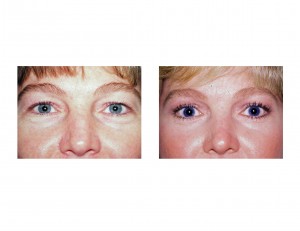
Despite the often great results that result from blepharoplasty surgery, it is not an operation that is immune from potential complications. What is unique about blepharoplasty complications is that they involve eyelids which have the functional purposes of eye protection and lubrication. This often translates to a range of dysfunctional eye symptoms that can occur in addition to eyelid appearance deformities.
The upper and lower eyelids, however, have significant differences in the risks and types of complications that can occur. As a general rule, the incidence of lower eyelid problems greatly exceeds that of the upper eyelid after blepharoplasty manipulations. This is due to their anatomic differences with the lower eyelid being a tightly suspended structure across the lower eyelid whose support can be easily disrupted by incisions, skin removal and scarring from fat removal and orbital septum disruption.
The most common upper blepharoplasty problems are the removal of too much skin or fat. It is actually rare to ever remove too much upper eyelid skin. Removal of too much skin is reflected in an inability to have complete upper eyelid closure with the lower eyelid. Upper eyelid skin is fairly easy to stretch out and is aided by the flexibility of the eyebrow to move down slightly. Too much upper eyelid skin removal is really only a potential concern with it is being combined with a browlift, which ‘removes’ skin by pulling the upper eyelid upward. Only a skin graft can restore the upper eyelid when too much skin is removed. Fortunately this is uncommon.
The more common upper eyelid problem is either a visible incision line or when too much fat is removed. Hollowing of the upper eye can occur when too much fat, usually from the central fat pad, has been removed. It is the medial pad that fat should be taken from in the upper eyelid but it is easy to mistake the central pad for the medial one. This can lead to central hollowing. Fat grafting can reduce the hollowing and can be done with either a composite graft from the buccal fat pad or injections from liposuction harvest.
While the lower eyelid can have similar complications as that of the upper, they often are more visible and symptomatic. Lower eyelid retraction is the most severe problem and is usually the result of a subciliary lower blepharoplasty with skin, muscle and fat removal. Either too much tissue has been removed or its lateral resuspension has been improperly done. This results in a pulling down of the lower eyelid away from the eyeball. (ectropion) It is always greater in the outer part of the eye near its corner where support from the lateral canthus is the most needed. Many older patients are particularly prone to this potential problem because of a weakened and lax lateral canthal support.
Most of the time, lower blepharoplasty-induced ectropion can be corrected by lower eyelid release and tightening or reattaching the lateral canthal region. I find that this works most of the time for the common ectropions that are seen. In more severe cases, midface lifts or even skin grafts as a last resort can be done. Because gravity is a constant nagging factor, severe ectropions will only get long-term relief from tissue replacement. While concept of a lower eyelid skin graft can be disconcerting, its appearance can be improved by secondary skin resurfacing methods.
The problems that lower eyelid ectropion poses speaks as to why the emphasis of lower blepharoplasties in the past few years has been more towards transconjunctival techniques with limited eyelid skin removal. As always prevention is better than the cure and, despite an understandable patient desire for the smoothest lower eyelid possible, the ‘suffering’ from a few extra lower eyelid wrinkles is at least not physical.
Too much fat removal or lower eyelid hollowing is a complication, unlike ectropion, that is a delayed one and may not be seen for months to years. Again, fat replacement is the treatment but larger amounts are usually needed for the lower eyelid versus the upper. The size of the lower eyelid hollowing may therefore lend itself better to fat injection techniques.
Dr. Barry Eppley
Indianapolis, Indiana


